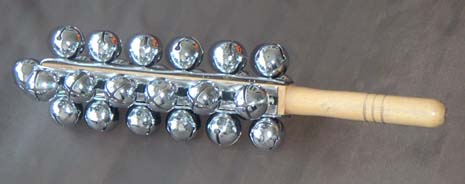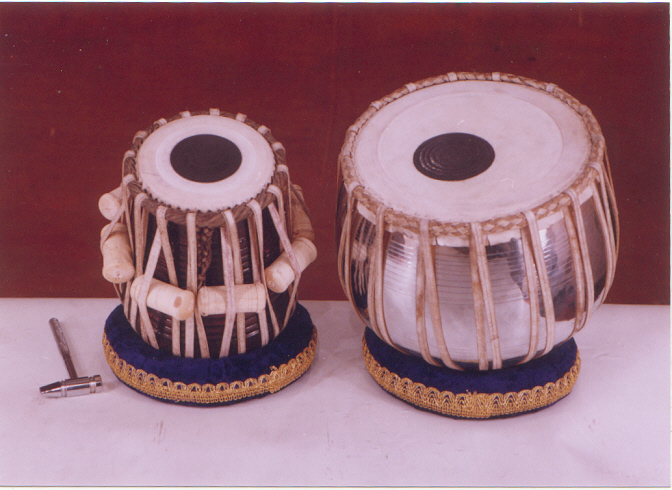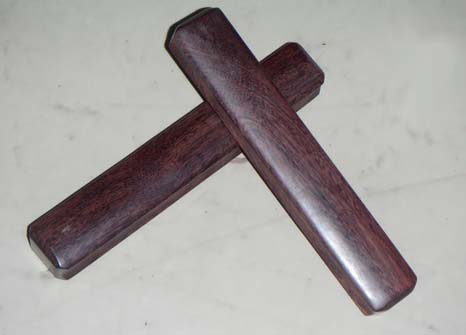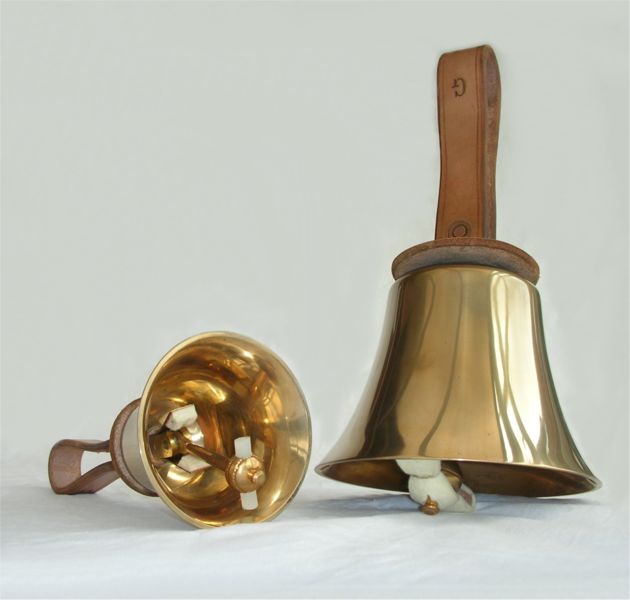
In the seminar this week we looked at some of the percussion instruments we might see in a school. Some of these were instruments I'd never seen before, and some of them were instruments that I had no idea how to play. So I thought it would be helpful for me, as a teacher, to do a bit of research and compile a list of percussion instruments. In the seminar we were challenged to pick an instrument and use it to make two different sounds, so for this list I will aim to list at least two ways of playing the instrument.
Agogo bell
Agogo bell
The two bells each make a different sound (at a different pitch). They can be struck with a beater, muffled with the hand, or squeezed together to make a clicking sound.

Frame Drum
There are different types of frame drums all over the world. They are traditionally played by striking with the fingers or palms. The placement of the strike (near the centre of the drum? against the frame?) affects the sound. They can also be played by running a brush, or fingertips, over the drum-skin, which makes a completely different sound. Resting a hand against the skin can muffle the sound by dampening the resonance.

Bongo Drums
The two bongo drums have different pitches are are traditionally played by striking with the hand or the fingers. The drum skin can be muffled with the hand, to create a different sound, and the drums can also be struck with beaters and drum-sticks.
Frame Drum
There are different types of frame drums all over the world. They are traditionally played by striking with the fingers or palms. The placement of the strike (near the centre of the drum? against the frame?) affects the sound. They can also be played by running a brush, or fingertips, over the drum-skin, which makes a completely different sound. Resting a hand against the skin can muffle the sound by dampening the resonance.
Could be played by striking with a mallet (or two mallets), or by running a striker along the metal to make a softer sound.
Note that gongs are tuned percussion, and so if students had more than one gong, or if different students had differently-pitched gongs, they could play a melody.

The guiro can be struck with a beater, or the beater can be scraped across the side of the instrument. The way it is held (with the handle, with a thumb in the hole, tightly, loosely) can effect the sound.
Hand Bells
Hold the handle and swing the bell to make it ring. The handle could be held loosely or tightly,which would affect the sound created. The other hand could be used to hold the bell, or the clapper, which would stifle the sound and make a different noise.
Note that bells are tuned percussion, and so if students had more than one bell, or if different students had differently-pitched bells, they could play a melody.

Idiophones such as Glockenspiels, Marimbas, Metalophones, Vibraphones and Xylophones
These are struck with mallets to create a sound. Different mallets would create different sounds and the instruments could also be 'muted' by holding them, or by muffling them with material.
Hold the handle and swing the bell to make it ring. The handle could be held loosely or tightly,which would affect the sound created. The other hand could be used to hold the bell, or the clapper, which would stifle the sound and make a different noise.
Note that bells are tuned percussion, and so if students had more than one bell, or if different students had differently-pitched bells, they could play a melody.

Idiophones such as Glockenspiels, Marimbas, Metalophones, Vibraphones and Xylophones
These are struck with mallets to create a sound. Different mallets would create different sounds and the instruments could also be 'muted' by holding them, or by muffling them with material.
More than one mallet can be used at a time (even more than one mallet per hand) to make chords.
Note: while researching this I found out about Lithophones, which are made out of rocks! Students may want to create their own Idiophone using natural materials, recycled materials, bottles filled with water etc. While Glass Harps are not idiophones, they are similar instruments that older students may want to try creating themselves.


Jingle bells
Jingle bells are played by holding the handle and shaking the instrument, either quickly or slowly. The bells can be held to muffle the sound. The bells can also be struck directly, with the hand or with a beater.
Rattles
The sound the rattle produces depends on how it is held (one hand, two hands, only holding the handle or holding all of the rattle) and how it is shaken (fast, slow, turned etc.). Students may construct their own rattles out of recycled materials and can experiment with the sounds produced by different materials. Maracas are a popular type of Latin-American rattle.

Tabla
Tablas are tuned Indian drums that come in pairs. They are played with the fingers and the palms of the hand, to create a variety of sounds with different pitches, timbres and resonances. Striking different parts of the drum also creates different sounds. I've never seen these in real life but I'd love to try them one day!
Tambourine
Tambourines can be played by holding the frame and shaking the instrument, or by striking the frame with the hand. Many tambourines have drum heads can be played like a frame drum.

Zils (Finger Cymabls)Tambourine
Tambourines can be played by holding the frame and shaking the instrument, or by striking the frame with the hand. Many tambourines have drum heads can be played like a frame drum.

Triangle
The triangle can make a different noise depending on the beater -a metal beater produces a ringing sound, a wooden beaters produces a duller sound and knitting needs can produce very quiet tones. The way the triangle is held - loosely or tightly - can impact on the resonance of the sound.


Wooden striking instruments - Claves and Wood Blocks
Claves are played by being struck together. The way they are held (tightly, loosely) can effect the sound.
Wood blocks are played by striking the block with a beater. The material of the beater, and the way the block and beater are held, can effect the sound.


Wooden striking instruments - Claves and Wood Blocks
Claves are played by being struck together. The way they are held (tightly, loosely) can effect the sound.
Wood blocks are played by striking the block with a beater. The material of the beater, and the way the block and beater are held, can effect the sound.
The finger cymbals are struck together. Depending on how tightly they're held, and whether they are allowed to resonate or are kept together after striking, different sorts of clanging and ringing sounds can be produced.





